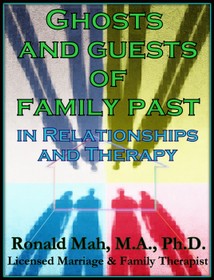11. Distancer-Pursuer Script - RonaldMah
Ronald Mah, M.A., Ph.D.

Licensed Marriage & Family Therapist,
Consultant/Trainer/Author
Main menu:
11. Distancer-Pursuer Script
Therapist Resources > Therapy Books > Ghost Guest Family Past

Ghosts and Guests of Family Past in Relationships and Therapy
Chapter 11: DISTANCER-PURSUER SCRIPT
by Ronald Mah

In a study of women and history of abuse, abused women characterized previous relationships as lower in quality than did non-abused women. Relationship failures likely reinforce fear of intimacy, resulting in both a more negative perspective of the relationship and their own role in it. Abused women's relationships may have more relationship dysfunction. On the other hand, early abusive relationships cause women to perceive past relationships as more dysfunctional would non-abused women (Davis et al, 2001, page 76). The cause and effect that may be suggested by these correlations might be mutual influential rather than being relevant in one direction or the other. In any case, the pattern or script of the relationship is recognizable between certain persons. This dynamic is not exclusive to abused women and abusive men, but may have the conversed relationship of abused men and abusive women or between homosexual partners. However, it is a stereotype that many therapists experience in their clients, and as such bears examination. An abused woman somehow selects, is drawn into, or is chosen into another relationship of dysfunctionality with an emotionally if not also physically abusive partner. The emotionally abusive partner pulls away only to be pursued by the abused or neglected partner. The two individuals eventually reconnect. Once reconnected however the play resumes with further dysfunction and another round of the abusive man eventually pulling away or being emotionally or physically unavailable and the abused/neglected chasing after him again. "Why do they keep hurting me?" cries such a woman. An alternate yet often unvoiced question can be "Why do I always pick the jerks?" Related to that would be "Why don't I find nice guys sexy?"
An individual in a distressing relationship or having had a series of distressing relationships can point blame at the other person, the partner, the series of partners, or bad luck. Looking for love in another partner or hoping for better relationship luck may be looking for change in all the wrong places. Wampler (2003, page 511) does not find "a strong impact of the partner on one's interaction behavior… when family-of-origin experiences are having a negative impact on current relationships, the most effective avenue to relationship change may be through the individual, by focusing on the individual's perspective on the family of origin, rather than working through the current relationship to change the individual." The current relationship is more or less another pairing in a series of relationships that a particularly dysfunctional persona unconsciously seeks out. It is not the ill luck to find jerks over and over but the jerk-selection instinct and need of the individual that requires attention. In other words, if the individual had internalized healthier relationship and self-care instincts, he or she would not tolerate such negative partner prospects and thus, not have such bad "luck." Social learning theory would challenge the implicit self-condemnation as ones destiny to be doomed to such relationships. Social learning theory proposes that mate selection is not merely a function of luck: good or bad. Instead, it asserts that such a woman and all people are not born with pre-determined behavior patterns, but had acquired behavior patterns perhaps unconsciously. As such the focus of therapy or change would fall significantly on the individual versus on the couple's relationship exclusively. "…the origin of human behavior is primarily imitation: Children learn a repertoire of behaviors and schema from observation and modeling (Bandura, 1977). According to social learning theory, much of an individual's marital behavior is learned in one's childhood through observation of his or her parents in their marital interaction processes. From these early observations, children develop what Marks (1986) refers to as a marital paradigm. He defines this marital paradigm as 'the picture, the set of images we have formed about how marriage practice might be or seems to be done, for better or worse' (p. 13). This paradigm contains guidelines for normal marital functioning including a belief about marital problems and their solution, and serves as a foundation upon which subsequent relationships are structured (Wamboldt & Reiss, 1989). Marks suggests that because the path of least resistance is to fall back on the marital paradigms learned in childhood and adolescence, this paradigm continues to influence couple interaction throughout marriage" (Topham et al, 2005, page 103-04).
If an individual observes positive relationships and behavior in his or her parents, he or she will tend to duplicate functional attitudes, values, beliefs, and behaviors. If an individual experiences negative dynamics as in the case of acrimonious partner conflict including divorce, he or she would be highly challenged to internalize healthy interpersonal skills such as effective communication, conflict resolution, and compromising. Such skills are critical for individuals as partners to avoid destructive relationship hostility. Attachment theory proposes that intimate adult relationships are strongly influenced by affective events in childhood. The individual will internalize caregiver experiences to form models later relationships. Such templates guide expectations, perception, and behavior (Topham, 2004, page 103-04). Highly charged anxiety provoking experiences are likely to be imprinted onto the psyche of observing children.
Betchen & Ross (2000) explain a different version of the pursuer/distancer relationship in "Male pursuers and female distancers in couples therapy." Parents may have triangulated the future female distancer as a child. One parent was distant and passive- possibly rejecting, while the second parent pursued, dominated and/or controlled. To prevent being hurt from potential rejection, the now adult distancer seizes control of significant relationships. She cannot be dominated again as she was as a child. Subsequently, a woman distancer feels safer with men who pursue, who also have with tendencies to please women. Power is assured, while getting a desired nurturer. Balancing the relationship to share power becomes a threat to her security. She reacts as if there is a relationship coup where she will lose all power and control to her male partner. Although, the distancer wants nurturing, she fears being dominated. The male pursuer may have acquired his tendencies from also having been triangulated between the parents. In his case, he experienced one parent as the family bully. He rejected the dominant power position of the bully, perhaps having suffered his own victimization or identifying with the other parent who was bullied. Drawn compellingly to the role of supporter, confidante, and nurturer for his victimized parent, he continues this in his adult intimate relationships. Within himself, he has anger and a fear of the relationship becoming explosive and abuse. He fears his own power and possibility of bullying as well. He further fears that asserting a more balance equitable power dynamic with his partner will break his bond with the partner. This seems to be how his parents' intimacy bond was broken. "Throughout treatment, the therapist must help both partners to realize that their current interactions and reactions are too often artifacts from their pasts rather than in `real time' with each other" (page 21). Betchen & Ross described a male pursuer and female distancer. Gender roles however can be reversed, and the dynamic equally relevant in some same-sex couples. It is possible that cultural gender standards may create a greater tendency for one gender or the other to be the pursuer or distancer. However, the specific family-of-origin experiences of a child, whether male or female would have greater influence as to who becomes a pursuer or a distancer in relationships.

